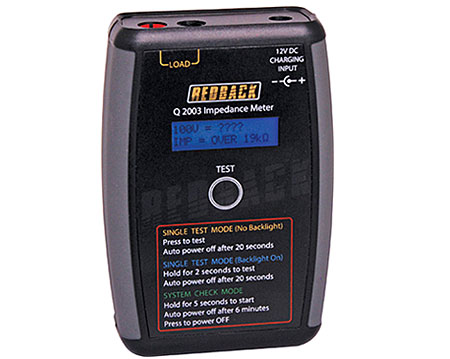- Home
-
Products
- Panels, Networking & Utilities Software
- Detectors, MCPs & Modules
- Alarm (Alerting) Devices
- Power Supplies
- Waterflow Devices
- Spare Parts
- Historic Products
- News
- Downloads
- Tools
- Projects
- About
- Support
- Sitemap
- BPIR
- Contact
News
Audio Impedance Meter Solves Amplifier Loading Problems

Some 100 Volt line speakers use more input power than their nominal rating. We have heard about several cases where an amplifier has been overloaded, even though the rated system load had been correctly calculated.
A digital audio impedance meter makes it easy to check for this kind of problem, before connecting a new 100 Volt (rms) line system. It also saves time when checking or fault-finding existing systems.
We now have in stock, a quantity of Redback Q 2003 digital audio impedance meters. The Q 2003 connects to a 100 Volt line in place of the amplifier, and automatically displays speaker loading (Wattage) and AC circuit impedance.
To measure impedance, the Q 2003 impedance meter puts an audio tone on the 100 Volt line. The meter automatically calculates the speaker loading based on the measured impedance. Both results are displayed on a 2-line backlit LCD display.
The meter also has a System Check mode. In this mode it puts out a 1 kHz tone, allowing the user to walk around the installation and check that all connected speakers are working. System Check mode automatically stops after six minutes.
It is usually impracticable to check a 100 Volt line with a DC multi-meter. With the speaker transformers connected via series capacitors, a DC meter will simply measure the "end-of-line" terminating resistance. It is quicker and easier to diagnose potential faults with an AC impedance meter like the Q 2003.
The Q 2003 features auto power off, a built-in charger for charging its internal NiCad or NiMH battery from an external 12 Volt supply, and a rugged hand-held case.
The Q 2003 digital audio impedance meter is a time-saving addition to the tool-kit.
Click here to inquire about the Q 2003 digital audio impedance meter
Correction 25 March 2019: The original version of this story incorrectly said that a DC multi-meter connected across the 100 Volt line will simply measure a short circuit.
Posted in Product News; Tagged Tools, Amplifiers;
Tags
- Alerting Devices
- Amplifiers
- Analogue Addressable
- Audio Distribution Modules
- Cabling
- Conventional Beam Detectors
- Conventional Detection
- Covid_19
- Deluge System
- Detectors
- Drip Loop
- Early Warning Fire Detection
- Equipment Cabinets
- Events
- F100A
- F16e
- F220
- F4
- FAAST
- Fire Alarm Control Panels
- Fire Alarm Mini Panel
- Fire Alarm Panel Keyswitch
- Fire Door Holders
- Fire Graphic System
- Fire Show
- Fire System Management Application
- FireMap
- FireUtils
- Hazardous Area Detection
- Honeywell
- Interfaces and Repeaters
- interns
- IYM
- LED Mimic
- Linear Heat Detection
- Lockdown
- Manual Call Points
- manufacturing
- Net2 Network Systems
- Operations
- OSID - Open Area Smoke Imaging Detection
- Pertronic Offices
- Pertronic Production
- Pertronic SOS
- Product Support
- R&D
- recycling
- Remote Display
- research
- Residential Panel
- Seismic-tested Fire Alarm Panel
- smoke sensor
- Speakers
- Sprinkler FBA
- STEMM
- Strobes
- Suppression
- Takina
- Thermistor Heat Detectors
- Tools
- training
- Unwanted Alarm
- Waterflow Devices
- Weatherproof
- Weatherproof Detectors
- Wiring

